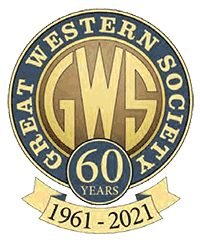A History of Radstock North Box
The history of Radstock North Signalbox and its predecessor, and of the railway lines and level crossing they controlled, is a surprisingly complex one and whilst considerable research has been undertaken there are still a few questions to be answered.
Looking at Radstock today it is hard to remember that it was once the industrial hub of the North Somerset Coalfield and as such a target for many canals, tramways and railways.

1909/1910 postcard view of Radstock looking East. Shewing the S&D double track, level crossing and signal box on the left and the Great Western equivalents on the right. Note that the S&D line crossed over the GW out of shot to the right of the picture. The single track branch to the left of the picture is to Clandown colliery, whilst the white path coming through under the S&D marks the course of the former narrow gauge tramway to Clandown colliery
(GWS Collection)
Railway construction and the original McKenzie & Holland Box
1845
A branch line to Radstock from Frome was authorised, together with several other lines, under the Wilts, Somerset and Weymouth Act of 30th June 1845, with the intention of tapping the mineral wealth of the North Somerset Coalfield. This act was promoted by the Wilts, Somerset and Weymouth Company, a nominally independent company controlled by the GWR.
(Thomas. 1973. p.164; Vincent 1990. p.23)
1850
The Wilts, Somerset and Weymouth Company was absorbed by the Great Western Railway on 14th March 1850, before significant work had been started on the Radstock branch line. The line from Westbury to Frome was opened on October 7th 1850
(Thomas. 1973. p.170; Vincent. 1990. p.24)
1854
The broad gauge line from Frome to Radstock was inspected by Colonel Yolland, his report being dated 23rd October 1854. He discovered that “no arrangements have yet been made for working the line for passenger traffic at Radstock as no station accommodation or platform for passengers has yet been provided and the station is not yet entirely enclosed” and was in consequence perhaps unsurprised to learn that “there is no present intention to commence working the line for passenger traffic” [Inspector's Report] (TNA MT6 11/109).
The GWR broad gauge single line opened 'for the conveyance of minerals' on the 14th November 1854.
(Thomas. 1973. p.178; Vincent. 1990. p.27)
1863
A second line to Radstock, this time from Bristol, was authorised under the Bristol and North Somerset Railway Act of 21st July 1863.
(Thomas. 1973. p.1978; Vincent 1990. p.34)
It will become of importance later in the story that at this stage it was proposed to carry the railway over the Bath-Wells turnpike road at Radstock on a under bridge.
1866
A further Act of Parliament was obtained for a deviation of the line at Radstock - The B&NSR Deviation Act.
(Vincent. 1990. p.34)
1869
Yet another Act of Parliament was obtained - The B&NSR (Deviation at Radstock) Act of 30th November 1869. The main significance of this act being, that the original proposal for a bridge had been dropped in favour of a level crossing.
(Vincent. 1990 pp. 34, 52
At this time the working timetables for the GWR's, broad gauge, Chippenham to Radstock line indicate a method of working for the first time, namely that “This is a single line worked by a pilotman” (TNA RAIL 937/11).
1871
The bill for the Somerset and Dorset Railway's Bath extension was passed in 1871 for a line passing through Radstock with the Bath-Wells turnpike road carried above it on an over bridge.
(Thomas. 1973. p.207)
1872
The working timetables indicate that as of 18th November 1872 train staff working was introduced, noting that “This is a single line between Radstock and Frome worked by Train Staff” (TNA RAIL 937/17).
1873
An undertaking was received by the Board of Trade from the B&NSR regarding the method of working, dated 29th August 1873. This states that initially the line is to be worked as two one-engine-in-steam sections, namely Bristol-Pensford and Pensford-Radstock (TNA MT6 117/17).
After what MacDermot (1964. p.45) describes as “a tragic financial story too involved to be recounted here and of little interest nowadays” the line was finally ready for inspection. This was undertaken by Colonel Rich whose report of 2nd September 1873 notes that “There is a level crossing of a public road at Radstock. The gates close across the road and railway. They are worked from the adjacent signalcabin and are interlocked with the signals” and also that “All the signals and points on the railway are worked from signal cabins and interlocked. The arrangements for working the line on the block telegraph system were very nearly completed”.
His list of work still required, included some necessary signalling work: “The gates at Radstock required bolts - Clocks were required in some of the signal cabins and the shelves for the telegraph instruments interfered with the view of the signalmen and with the working of the boxes and required to be fixed at the sides of the cabins - Diagrams of the lines of rails and signals are required in the signal cabins”.
Finally he noted that “the locking of the signals and points at Radstock, which were arranged for working up and down lines at that station required to be changed for working the station as a single line until such time as the railway is opened to Frome and Radstock and the station is used as a passing place” [Inspector's Report] (TNA MT6 117/17).
However, despite these reservations he approved the opening of the line which was opened the following day as the narrow (standard) gauge, passenger carrying, Bristol & North Somerset Railway on the 3rd September 1873.
(Thomas. 1973, p.178; Vincent. 1990. p.11)
The event was naturally widely reported in the Bristol and Bath papers. It had apparently been intended to open the line on Tuesday 2nd, the Wednesday Bristol Times and Mirror noting that “The Great Western Railway Company had announced the opening of the new railway from Bristol to Radstock for yesterday, but the arrangements could not be perfected in the time, and the officials were unable to carry out their intentions” [Press Article] (BTM 3/9/1873).
The following day the Western Daily Press were able to report on the actual opening, and concentrated on the scenic delights to be viewed from the train noting “such a view as can only be seen in England” and “miles of thoroughly English scenery” [Press Article] (WDP 4/9/1873).
The Bath Chronicle (a weekly paper at this time) chose to concentrate on the troubled financial history of the company [Press Article] (BC 4/9/1873), a theme taken up with relish by the Bristol Times and Mirror in its Saturday edition which describes the history of the North Somerset as “one of the most calamitous that the railway world has ever had to contend with” and warming to their tale, contend that “... if we were to produce a history of the quarrels and contentions at the half-yearly and special meetings of the company, and the extraordinary phases of railway finance which came before the London law courts, or to lift the veil of privacy and tell of the ruin of families through the speculations of the too-confiding heads of those families, who were talked into risking their tens of thousands when the company was really in a state of bankruptcy, we should furnish such a fund of romance as has never before been experienced in the railway annals of the West of England” [Press Article] (BTM 6/9/1873).
The Somerset and Dorset Railway obtained a further Act in which the proposal for the Bath-Wells turnpike road to be carried above the line on a bridge at Radstock was dropped in favour of a level crossing.
A Controversy: Radstock No. 3 (Not No. 1?)
All known reference works (secondary sources) suggest that the box was originally named 'Radstock No. 1'. This is the name given in Vincent (1990. p.246), The Signalling Record Society (2007, p.153) and on the John Hinson CD. It has now been established that all of these works have taken their information from a single source, namely the late John Morris.
Extensive research has provided evidence from two separate primary sources that on this occasion Mr Morris was mistaken, possibly misled by the changes to up and down directions on the line (see below), and that the box was originally 'Radstock No. 3'.
In the Working Timetables, as early as 1891 (TNA RAIL 937/54) mention is made of Radstock Number 3 which is to be closed after the last train on single line - obviously the only box at Radstock which operated a single line was the North Box. Further, in the January 1896 timetable (TNA RAIL 937/64) the name in the table of box closing times becomes Radstock Station and this in turn becomes Radstock North in May 1897 (TNA RAIL 937/66).
The Inspectors report of 2nd September 1873 on the opening of the B&NSR [Inspector's Report] (TNA MT6/117/17) mentions a box operating the gates at Radstock, but does not name it. The report on the proposed opening of the Frome to Radstock Section to passengers [Inspector's Report] (TNA MT6/142/10) which Vincent quotes (p.65) as stating that “the GWR were going to establish an electric communication between No.1 and No.2 signalboxes at Radstock, the 'Gates' and the 'Yard' respectively ” actually reads “At Huish's Coal Siding an electric communication is to be established between Nos.1 and 2 Signal Boxes.” This would suggest the South end of the layout rather than the North.
Also, it is believed that, it was general practice to number signalboxes 'away from London'. That is to say the box nearest London would be Number 1 and the numbers would then count away in a Down direction. (See note on [Up and Down]).
It would seem that there is overwhelming evidence that the original box on this site was 'Radstock No. 3'.

The original McKenzie and Holland Box
(GWS Collection)
The passenger station at Radstock with its original signalbox controlling the level crossing, opened therefore, with the line, on 3rd September 1873.
This tall wooden box on a brick base was built by McKenzie & Holland (and is of a type referred to by the Signalling Record Society as McK&H ‘Type 1’), as were all the original boxes on the North Somerset.
(Signalling Record Society, 2007. p.153; Signalling Study Group. 1986. p.92, p.166; Vincent. 1990. p.241)
1874
The Bristol & North Somerset Railway had applied to the Board of Trade for a revised working method between Bristol and Radstock using “the Train Staff and Ticket system, supplemented by the block telegraph” this was approved on 19th June 1874 (TNA MT6 117/17). The single line section at this time was from Radstock North Box to Pensford and a triangular train staff and triangular blue tickets were used (TNA RAIL 937/23).
The parallel Somerset and Dorset Railway with its own Radstock station , level crossing and associated signal box, almost adjacent to the GWR station, but with no rail interconnection, was opened on the 20th July 1874.
(Thomas. 1973. p.208; Vincent. 1990. p.35)
Within weeks the two parallel level crossings were generating complaints and Colonel Yolland was despatched by the Board of Trade to investigate. He was told that on 19th September “when there are only 6 down and 6 up trains daily on the Bristol and North Somerset Railway and 13 down and 11 up on the Somerset and Dorset Railway” the gates were closed for a total of “1 ¼ hours for the Bristol and North Somerset Railway, and 4 hours and 36 minutes for the Somerset and Dorset Railway between 5:15 am and 10:11 pm”. He concluded that the two level crossings together “constitute an exceedingly objectionable and dangerous level crossing which as far as I know cannot be paralleled as far as its physical construction is concerned by any level crossings in the United Kingdom” and went further to state that “I consider that Radstock exhibits a decided blot in our system of railway regulation which has permitted two separate lines and two separate stations to be constructed within a few yards of each other, in so small a place as Radstock, where one joint station could have answered every purpose to the great convenience of the public making use of these lines.” His conclusion was to “recommend the Board of Trade to exercise the powers conferred by the 7th section of the Railway Clauses Act of 1863 and to order the erection of bridges over these two level crossings for the purpose of carrying the turnpike road over the Bristol and North Somerset and the Somerset and Dorset Railways, instead of passing across them on the level”. [Inspector's Report] (TNA MT6 644/5 {31/10/1874})
A Narrow Gauge line from Radstock to Frome
1875
The Frome to Radstock section was converted to narrow (standard) gauge by the GWR by June 1875, when an Inspection by Colonel Yolland for the Board of Trade took place.
(Thomas. 1973. p.178; Vincent. 1990. p.60)
His report, dated 25th June 1875, notes that “the requisite arrangements have been made for working the traffic on the absolute block system and on the single portion of the line in conjunction with the train staff, but I have not received any undertaking of the Company's as to the mode of working intended to be adopted”. However he also notes that “the points and signals are not yet generally connected with the levers in the Signal Boxes and in some instances which were pointed out on the ground, the facing point locks required closer adjustment. Clocks have also to be placed in the Signal Cabins”.
Times have clearly changed for he goes on to state that he is “unwilling to recommend that the opening of this line for passenger traffic should now be postponed on this account or from the connecting up of the points and signals with the levers in the Signal Boxes not having been yet completed, if it is understood that these things will at once be completed, and that the Inspector of the Board of Trade, may if thought necessary again go over the line, when these few requirements have been attended to” [Inspector's Report] (TNA MT6/142/10).
A through narrow gauge passenger service started between Frome and Bristol on the 5th July 1875.
(Thomas. 1973. p.178; Vincent. 1990. p.62)
The local press declared that “The boon conferred upon the travelling public by the opening of this small branch is considerable” as the journey from Bristol to Frome could now be “accomplished in an hour and a quarter without change of carriage” as opposed to two hours via Bath and Westbury [Press Article] (BTM 6/7/1875).
In August The Board of Trade took out orders requiring both the Bristol & North Somerset, and Somerset & Dorset railways to replace their level crossings with overbridges but suggesting, in an accompanying letter, that the company might consider “a more convenient and practicable alternative than that which the Legislature has prescribed viz. The formation of one continuous bridge over the two railways. This would obviously prove the least expensive as well as the best remedy for the existing mischief” [Order and accompanying letter from BoT] (TNA MT6 644/5).
(Vincent. 1990. p.63)
1877
Clearly, nothing was done to replace the level crossings for on 7th April 1877 the Radstock Local Board wrote to the Board of Trade, pointing out that the 18 months “allowed by your order requiring a bridge to be built in lieu of these level crossings has now expired” and nothing had been done. They also noted “that the bridge or viaducts as proposed to be erected would so seriously injure the property of the place” and wondered if a subway might not be constructed instead [Letter] (TNA MT6 644/5).
The Board of Trade moved to take out a Writ of Mandamus to force the Railway Companies to take action, but there was evidently concern as to whether the Board of Trade had the necessary powers. The main concern was that given the limited space between the two crossings and a requirement in Sec 50 of the Railway Clauses Consolidation Act 1845 that “the ascent to an overbridge shall not be more than 1 foot in 30 ft” it was physically impossible for two separate bridges, complete with their approach ramps descending to ground level, to be built. The alternative suggested in the letter accompanying the original order whereby each company built half a bridge with a raised section joining them, whilst a practical solution to the problem was not, it seems legally enforceable either. An acrimonious exchange ensued between the Board of Trade's Solicitor's Department and its Railway Department [Letter from Solicitor's Department] - [Reply from Colonel Yolland] (TNA MT6 644/5).
The application for a writ went before the Lord Chief Justice and Mr Justice Mellor on 19th November 1877 and was refused on the grounds that it was unenforceable for precisely the reasons noted above [Press Article] (TT 1/2/1878).
1878
On 31st January 1878 Radstock level crossings even got a mention in Parliament. The Attorney-General admitting, in response to a question from Major Allen that there was little to be done, and almost admitting that the fault had been with Parliament in agreeing to the crossings in the first place. “I fear there is no remedy for the grievance complained of unless the Legislature be resorted to. It is to be regretted that the railway companies originally induced Parliament to sanction the crossing a highway on the level by two lines of railway placed so near to each other as to create danger.” [Press Article] (TT 1/2/1878).
1882
With the opening of the Camerton Branch a signalbox was provided at Hallatrow and the single line section now became Radstock North Box - Hallatrow. The triangular staff and triangular blue tickets were used for this section, Hallatrow - Pensford being controlled by a new round staff and round white tickets.
(TNA RAIL 937/49; See also Vincent. 1990. pp.241, 249)
1884
With complaints about the nuisance caused by the crossings continuing, a Board of Trade inquiry was held in January under the chairmanship of Alexander Miller QC to consider whether the crossings “constituted such a danger to the public safety that the Board of Trade, exercising the powers it possessed, should require a modification of the arrangements; and, secondly, whether, if they constituted such a danger, there were practical means, having regard to all the circumstances, by which it could, be met.” [Press Article] (TNA MT6 644/5). The report suggests that little actual danger was caused but that delays were considerable. A bridge was thought to be impractical without “inflicting very serious damage on a great quantity of valuable property on the south side thereof. It would in fact place the entire town of Radstock in a hole” and the question of enforcing construction again arose. “Besides all this there is the further difficulty that there is not space enough between the lines to admit of the construction of two separate bridges of this height, and there does not appear to be any power, statutory or otherwise, to require the companies to unite in the construction of a common bridge.” A subway was a possible alternative, but to build one “would involve the raising of the levels of the railways from 10 ft. 6 in. to 11 ft., and would require a complete reconstruction of both the stations, and of the goods yard of the North Somerset Railway. Whether the construction of a common subway was thought to be enforceable when a bridge was not is not discussed.
A further possibility would be to build a small subway but this “would fail to provide sufficient accommodation for the heavy traffic of the district, and would be altogether inoperative in removing the danger arising on market days from the proximity of the level crossings to the market place”. The report goes on to note that “the delays and inconveniences complained of are to a great extent caused by the fact that the gates across the North Somerset Railway are kept shut during the whole time that the trains are standing in the station, although such trains are in every case clear of the level crossing, and although in the case of trains coming from Bristol the crossing might be used with perfect safety the moment the train has reached the station. This is caused by the interlocking of the gates with the station signals. The gates cannot be opened while the signals are down, and therefore they must remain closed, not only all the time the train is standing in the station, but until it has passed the signal box on its way toward Frome.” It was suggested that removal of the interlocking between the gates and the Frome-bound starting signal would significantly reduce the delays. Even this small action was not undertaken lightly with various letters to the Inspectorate ensuing to clarify that this was really what they wanted. Eventually however this was done, in March 1884, and indeed proved to be the only step ever taken to reduce the delays caused by the two adjacent level crossings [Official Inquiry Report] (TNA MT6 644/5).
The Bristol & North Somerset Railway was finally absorbed by the GWR on the 1st July 1884.
(Vincent. 1990.p.67)
1896
Apparently, the lever frame which was in the box when it closed, and which was subsequently purchased by the Great Western Society along with the GWR box, dates from 1896.
(Signalling Record Society. 2007. p.153; See also Vincent. 1990. p.241).
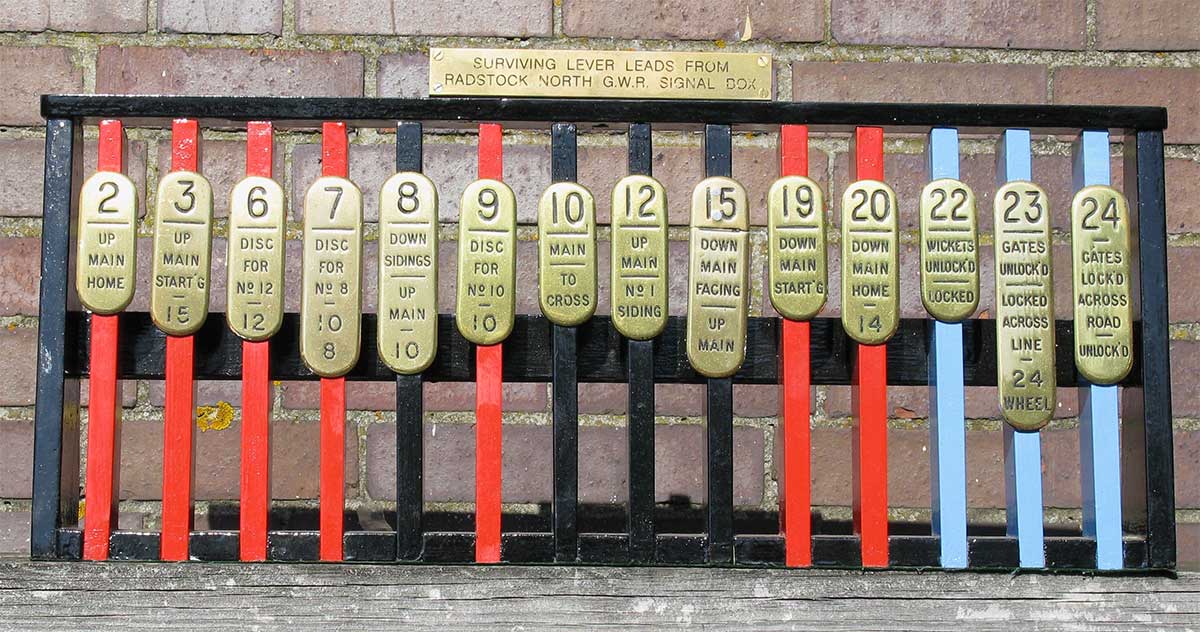
The brass lever leads which were still in place when the box closed, are now in the Great Western Trust collection and on display in The Signalling Centre at Didcot. R J Heron - 24-May-09
It is a GWR 24-lever double-twist locking frame with 5¼ inch centres, with distinctive elevated treads between the levers. This latter feature being typical of earlier frames. Double-twist frames were manufactured by the GWR from around 1890-1906 and although criticised for their tendency to wear, some lasted in railway service until the 1980s.
(Adams. 1993. p.212)
This frame must, therefore, have originally been installed in the tall McKenzie and Holland Box and later lowered to a new situation in the replacement GWR box.
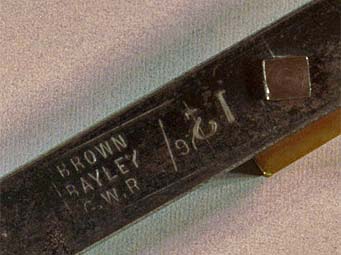
Mystery No.1
Interestingly, a stamp on part of the conditional tappet locking bears the figures '97, but it is not known if this was the date of manufacture or purchase of the steel, or indeed if was even a date. Brown Bayley were a firm of steelmakers in Attercliffe, Sheffield. In any case, it is possible that the conditional locking is a later addition to the frame. It is not possible to construct conditional locking using the double twist principle.
(Q. What is the significance of this stamp, and what, if anything, does it tell us about the date of manufacture of the frame?)
The Signalling Record Society state that the Horizontal Tappet locking was added when the box was rebuilt in 1909, which would seem reasonable.
(Signalling Record Society. 2007. p.153)
1897
The box was renamed ‘Radstock North’, the new cast iron nameplates for both Radstock North and Radstock South boxes having been ordered on 14th December 1896.
(Signalling Record Society)
On 3rd October 1897 the Electric Train Staff replaced the train staff and ticket and disc block telegraph as the method of controlling the single line sections on the route. The section was now from Radstock North Box to Old Mills.
(TNA RAIL 937/67)
The Great Western Signal Box
1908
A new timber box top was ordered by the GWR on 9th September 1908 from Reading Signal Works, according to notes taken from an original signal department order book.
(Signalling Record Society)
1909
Things were obviously busy on the Radstock coal field as in the 4th February 1909, General Manager's Fortnightly report to Traffic Committee he is seeking the directors approval to employ several additional staff for the North Somerset line including two signalmen at Radstock as there had been a “large increase of coal traffic between Bristol and Radstock due to the additional output from the collieries and the opening of the new Dumberton [sic - Dunkerton ?] colliery necessitating the North Somerset line - a single line - being kept open continuously” (TNA RAIL 250/435).
It is not known exactly when the new box was erected but, bearing in mind the order date, it was probably during the course of 1909. Photographic evidence would also back this up as there is a photograph (No.22 - See ‘Published Photographs’) which shows the old box together with a bus service which started in 1906 which confirms that the new box was not built before this date, and another which can be dated to 1909/10 (No. 4) and shows the new box. The new box had a wooden upper storey, which was prefabricated at the Reading Signal Works of the GWR, mounted on a brick base 8ft high and measuring in plan some 12ft by 18ft 2ins.
Another Controversy: The Brick Base
It has been suggested that the new box was built on the original brick base of the McKenzie and Holland box, extended in height by a couple of feet (Vincent. 1990. p.241). This supposition is presumably based on pictures, such as the one below, which seem to show new courses of brickwork on top of an earlier original.
However there are two factors which would appear to make this conclusion unsatisfactory. Firstly the two locking room windows were not part of the original box, and have indeed been formed using the special sloping engineering bricks to make the window sills which are absolutely typical of the GW box of the period. Had these windows been inserted into an existing brick structure it would be reasonable to expect signs of modification to the brickwork surrounding the windows and this is clearly not the case.
Secondly McKenzie and Holland signal boxes were, as far as is known, always built to a limited number of standard dimensions, and boxes having the window layout seen in photographs of the earlier box were built to a length of 16ft 8ins (Signalling Study Group. 1896. pp.88-93). The Great Western box at 18ft 2ins obviously does not match this dimension.
It therefore seems more likely that the McKenzie and Holland box was completely demolished and a new brick base provided on the same site, probably using some of the same foundations. It appears that during the course of construction, either a different brick has been used for the topmost layers from the outset or possibly these layers had to be re-laid for some reason.
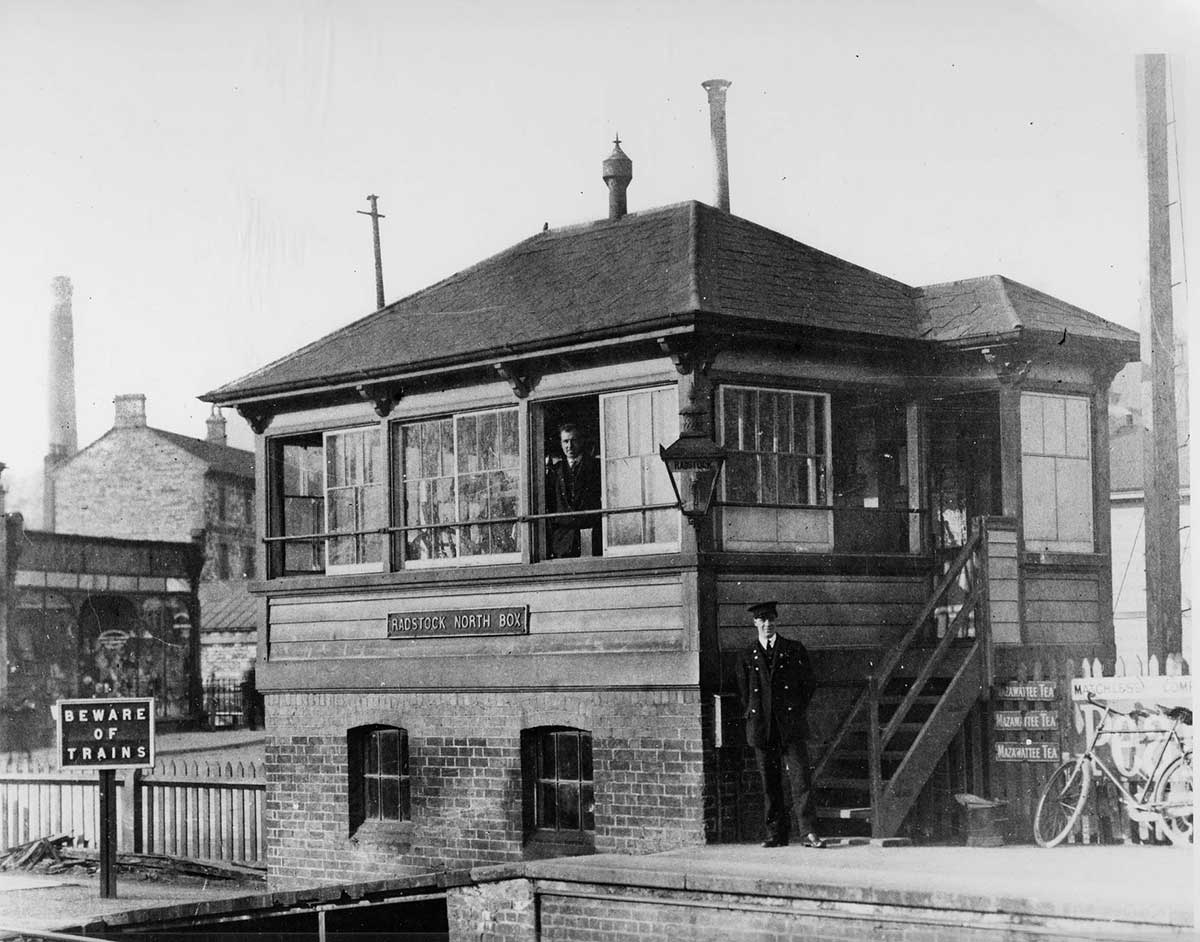
Radstock North Box in the 1930's(?) (GWS Collection)
The new box was of the type referred to by the Signalling Record Society as Type 27C Top, having a hipped roof, large decorative eaves brackets, and a 3-up 2-down design of operating floor window intended to offer improved visibility.
The system of classification uses the ‘7’ to indicate the type of box and the ‘2’ to indicate that the box is of wooden construction. Radstock North having an entirely wooden top and a brick lower storey does not easily fit into this classification!
(Signalling Record Society. 2007. p.153; Signalling Study Group. 1986.p.163)
Mystery No. 2.
Type 7 boxes built by the GWR between 1906 and 1925 were of subtype Type 7d. Radstock box is something of an oddity, for whilst conforming broadly to the specification of a 7d box, having a stove and stovepipe and two courses of splayed plinth brick forming the locking room windowsills, it has several peculiar features.
Indeed, a brick-to-floor box is itself unusual as type 7 boxes were almost always all timber or all brick. Having a rear window is unusual in any signalbox, though with the need to watch road traffic approaching the crossing, the need for this variation can be easily understood. Also, instead of ridge tiles the box retains the lead flashing typical of the 1896-1900 (Type 7a) box. Neither is the external porch typical of a Type 7 box, which generally had internal staircases.
(Q. Why does a box built to a standard pattern, at a central workshop, have so many variations from that standard?)
Mystery No. 3
At some stage, the main rodding run to operate the points at the east end of the station, which had previously run under a boarded walkway between the tracks through the platforms, was removed. The new rodding run unusually came out of the rear of the box, and passed down the back of the platform, leaving only the rodding operating the gates and associated locks coming out of the front of the box. A photograph supposedly taken in 1906 shows the original rodding and walkway still in place, so the alteration was clearly made after this date.
(Robertson. 1990. p.226; Casserley. 1975 pp.26-27)
(Q. When was this done, and why ?)
Horizontal Tappet locking was added to the original double twist frame at about this time.
(Signalling Record Society. 2007. p.153)
1914
A local paper reports on Great Western Railway Works in 1914, citing various articles in the Great Western Railway Magazine. As well as major developments at Paddington and achievements at Swindon Works including the production of two ambulance trains, the provision of additional sidings at Radstock is noted. No reference is made as to whether these were controlled by North box.
(WDP 07/01/1915)
1930
Complaints about the level crossing once again result in ‘questions in the house’, as on 27th November 1930 the Western Daily Press reports the local MP asking the Minister of Transport about the “deadlock between the local authority and the railway companies respecting the proposed alteration of the level crossing at Radstock”. The minister replied that there was no deadlock and any delays had been down to staff changes at the Urban Council, and that plans would be submitted to the County Council that week. [Press Article] (WDP 27/11/1930).
(Q. Which proposed alterations are being considered here? The reference to 'railway companies' (plural) presumably implies S&D and GWR, but surely this can't refer back to the last known proposals for change from the 1884 enquiry, or does it perhaps relate to the widening plan of 1936 below?)
On occasions, however, it was the road user causing problems for the railway! On 15th December 1930 the Western Daily Press reported that the local colliery manager had crashed his car into the crossing gates, resulting in considerable damage and avoiding disaster only by the Signalman's prompt action in stopping the approaching train [Press Article] (WDP 15/12/1930).
1931
On 17th December 1931 the GWR Signal Engineering Department, Engineering Committee, approved the expenditure for the “Renewal of Electric Train Staff Instruments 30 years old” at Radstock and Hallatrow at an estimated cost of £125 (TNA RAIL/250/557).
1936

In 1936 a proposal was drawn up to widen the Great Western level crossing towards the station. It is believed that this work was subsequently carried out though the date is not known.
(WSRO)
1937
On 16th December 1937 the GWR Signal Engineering Department, Engineering Committee, approved the expenditure for the “Renewal of two signals and point connections” at Radstock North at an estimated cost of £272 (TNA RAIL/250/558).
1939
On 5th October 1939 the GWR Signal Engineering Department, Engineering Committee, approved the expenditure for the “Renewal of level crossing gate stops and connections” at Radstock at an estimated cost of £290 (TNA RAIL/250/558).
Q. Might this relate to the 1936 proposal (or imply the 1936 proposal was not carried out)?
1949
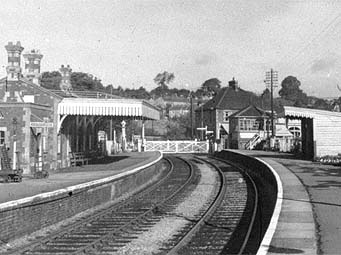
After nationalisation the station was renamed Radstock West on 26th September 1949.
The former S&D station was renamed Radstock North.
(Avon County Council. 1984. p.33; Clinker. 1978)
1951
It was not until 1951 that the box names were changed to bring them into line with the new station names - the former GWR Radstock North box being renamed Radstock West.
The former S&D boxes, became Radstock North 'A' and Radstock North 'B' at the same time.
(Vincent, 1990, p.241)
1957
The Railway Regulation Act of 1842 required that “level crossing gates were to be kept constantly closed across a public road where not required to be opened for road traffic, unless the Board of Trade were to order otherwise”.
(Hall. 2000. p.103)
With increasing road traffic this position eventually became unworkable and the Board of Trade and its successors increasingly authorised the gates to be normally closed across the railway. At Radstock it is to be presumed that the gates had been kept normally across the railway for some time, but apparently this had never been officially sanctioned; for in a letter dated 17th October 1957 the Western Region General Manager's Office requests that the Minister will issue the necessary order. The order was duly issued in November 1957 by CRS Wilson the then Chief Inspecting Officer of Railways (TNA MT114 2792).
1959
The last passenger train to Radstock (West) station ran on Saturday 31st October 1959.
(Phillips. 1994. p.22; Thomas. 1973. p.178; Clinker. 1978)
[Press Article] (WDP 2/11/59) [Press Article] (BC 2/11/1959) .
1963
The station buildings were demolished.
(Vincent. 1990. p.15)
Yet Another Controversy: Reversible Running ?
It is suggested that by 1964 “The down line was signalled for reversible running and the up line used as a loop” through the platforms (Mitchell & Smith. 1986. Plate 46). The photograph for which this statement provides part of the caption, shows the Bristol-bound starting signal relocated to a position in the middle of the former Frome-bound platform. This was not however a provision for reversible running, as stated, but merely a signal movement to improve sighting, made necessary by the construction of a row of shops on the site of the former Bristol-bound platform. A photo of the box diagram (Vincent. 1990. p.243) which incorporates the 1966 changes,clearly makes reference to up and down lines. (See note on [Up and Down]).
1965
The station was closed to all traffic on 29th November 1965.
(Vincent. 1990. p.157; Clinker. 1978)
1966
On 6th March 1966 a new connection was made between the former S&D and GWR lines some quarter mile west of the old station. This allowed the S&D line to be closed, leaving only the length of line through Radstock North (S&D) yard and out to Writhlington in situ. The only remaining traffic, being coal from Lower Writhlington Colliery, S&D demolition trains and some traffic from Tyning Wagon Works (closed end 1967), was thus diverted via the North Somerset Line [Press Article] (SG 11/3/1966). The GW level crossing gates were disconnected from the box and henceforth were operated by hand when required .
(Coleford. 2002. p173/4; Handley 1979. p.63; Vincent 1990. p.159; RM May 1966, p.260)
Subsequently, it is suggested, the North Somerset line was effectively worked in two sections once more (as it had been in 1873/4), with the traffic from the former S&D line heading north to Bristol and traffic from Whatley Quarry, Mells Road, and occasionally Marcroft's wagon works being taken via Frome. The only traffic heading past Radstock GW Box was presumably that local traffic emanating from Kilmersdon Colliery and occasional trains of wagons from Marcroft's.
(Coleford. 2002. p.174; Vincent. 1990. p.191, p.204)
On 15th August 1966 the line between Mells Road and Radstock was officially closed to all traffic, though it was left in situ. Presumably at this stage, all traffic from Marcroft's Wagon Works and Kilmersdon Colliery was sent north over the GW level crossing and via Bristol.
1967
In 1967 British Railways proposed that the line between Radstock and Bristol be closed and the coal traffic be diverted via Frome.
(Coleford. 2002. p.174).
1968
With the proposed re-routing, Norton-Radstock Urban District Council saw a new opportunity to resume an old battle, to have the level crossings removed, by building a chord through the former Ludlows Colliery Sidings to replace the 1966 link, thereby permitting the diversion of Writhlington colliery traffic away from both level crossings. In a letter to the Ministry of Transport on 29th April 1968 they suggest that “the matter should be further investigated in the interests of dispensing with the two sets of level crossings which straddle the Principal Traffic Route and which, as a consequence, create a major traffic problem in the centre of Radstock, particularly during the peak holiday periods when motorists are using the A.367 as the main road to the south. Quite apart from the holiday season, the two level crossings, being so close together and on the main road through the town, create a serious traffic bottleneck and a real hazard to pedestrians.” (TNA MT 114/3048).
This final closure of the Radstock to Bristol line to all traffic occurred a few days earlier than planned due to landslips caused by flooding, on 10th July 1968, and all traffic was diverted via the reopened line to Mells and Frome.
(Vincent 1990, p.163)
In conjunction with this Radstock West Box was reduced to a ground frame controlling the crossing on 14th July 1968. From this time only the up line over the crossing was used
(Mitchell & Smith. 1986. Plate 47; Signalling Record Society. 2007. p153; Vincent 1990. p.241)
A meeting was held, on 24th July 1968, of officials from Norton Radstock UDC, British Rail and the National Coal Board (who owned the land) to look at the proposals for diverting the traffic away from the crossings through a new chord laid on the former Ludlows Sidings land. The outcome of this was a letter from BR(WR) to the local council, dated 19th November 1968, stating that the cost of such a project including renewal of a bridge over the Wellow Brook and upgrading the level crossing over the Frome road would be about £10,000-15,000. It seems that BR was not keen on the idea as they conclude that “whilst the board are prepared to carry out this work, they will not derive any material benefit therefrom, and are therefore unable to bear the expenditure involved” (TNA MT114/3048).
Neither could the council find the money, and in any case it was expected that Writhlington colliery would close in about five years leaving the crossings redundant, and consequently this idea was not progressed.
1971
A raft of coal wagons ran away whilst unattended in the yard and destroyed one of the gates on 6th January 1971. Fortunately nobody was injured, though “Mr Cedric Brown, of Welton Road, Radstock, had a narrow escape” according to the papers. [Press Article] (SG 8/1/1971). Apparently this was not the first such occurrence, a 'senior railman' being quoted as saying “Wagons haven’t got out of control here for more than 15 years until today. But it could happen again tomorrow if someone forgot the brakes”. The Western Daily Press decided to dramatise the matter with an article under the heading - “The runaway rail fear that grips a town” [Press Article] (WDP 7/1/1971). [Accident Report] (TNA MT114 2892) (See also Mitchell & Smith. 1986. Plate 46).
1973
The box was finally closed as a ground frame on 17th January 1973 with regular through running from Writhlington Colliery ceasing on 16th November 1973.
(Signalling Record Society. 2007. p.153; Vincent. 1990. p.241, p.167)
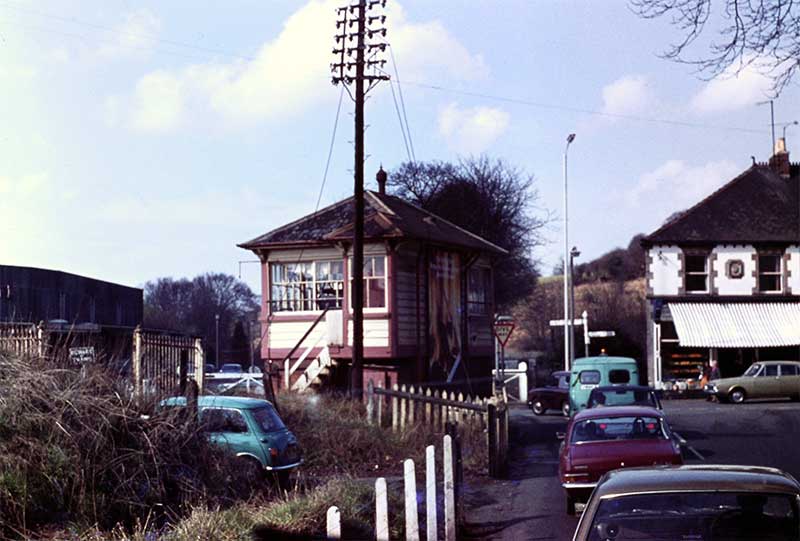
Radstock (GW) Box in the March 1973 (GWS Collection)
1975
The final train to run through the former GW station and over the crossing(s) was for the purpose of transferring the S&D Trust’s stock to the WSR on 16th October 1975.
(Vincent. 1990. p. 167)
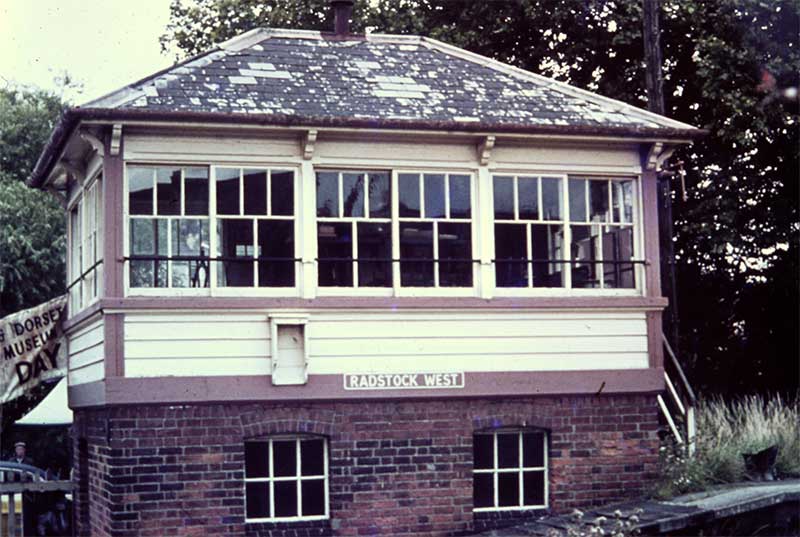
Radstock (GW) Box in the early 70s (GWS Collection)
After this the workings were cut back to a point short of the station. The local paper, in reporting the final journey noted that the Council were unrepentant, Councillor Jones stating that “The crossings were a bad bottleneck in the town” and reminding us that “the Urban Council fought for years to get the crossings removed, instituting traffic censuses in 1970 and in 1973 called to the County Council to install traffic lights at the junction of Frome Road and the Bath to Shepton Mallet road to get rid of the replorable [sic] conditions which exist at the Junction” [Press Article] (SG 24/10/1975). The article was completed with a section by Colin Maggs entitled “... But it should have been a bridge”!
The signalbox was removed on 23rd November 1975 by the Bristol Group of the Great Western Society and transported to Didcot Railway Centre [Press Article] (SG 28/11/1975).
1977
Some trial spoil trains from Kilmersdon Tip were run in spring 1977 but these were apparently not successful and the line remained in place to serve only Marcroft’s wagon works.
(Vincent. 1990. p.167)
1988
Radstock to Hapsford closed with Marcroft’s on 29th June 1988, only the line from Hapsford to Frome remaining to this day to carry the stone traffic from Whatley quarry. The line from Radstock to Hapsford is however is still in place, though in a very poor state as it is subject to a, currently stalled, preservation attempt by the North Somerset Railway. There is no longer any railway track in the Radstock station area.
(Vincent. 1990. p.16; Coleford. 2002. p.176)
The story of Radstock box continues with its move to Didcot Railway Centre in 1975 ...
As well as the published and public sources quoted above, I should like to thank:
- Chris Handley
- Chris Osment
- Tim Venton
- Mike Vincent
- Peggy Rowe and Dick Graham of Radstock Museum
- Derek Coe, Reg Instone and John Morris of the Signalling Record Society
who have all provided assistance with this research.
(Section still being researched)
